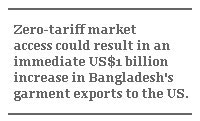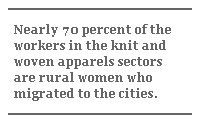The Price of Free Trade - Part I
The Price of Free Trade - Part I

DHAKA: Over the past several years, textile export has helped to lift Bangladesh out of its grinding poverty. But changing trade rules now threaten to take away those tools of enrichment. This drastic shift signals a major transition for the country's economic and social structure. How Bangladesh copes with this latest challenge will not only determine the country's future, but will also offer an example for other developing countries caught in globalization's shifting winds.
Production of ready made garments (RMG) has been one of the most important sectors of Bangladesh's economy, employing about 1.6 million workers, or one-third of its industrial labor force. Bangladesh was successful in translating its comparative advantage of abundant cheap labor into lower price for goods. And thanks to private sector entrepreneurship and financial incentives from the government, the sector saw robust growth in recent years.

Bangladesh's apparels sector has also, until now, benefited substantially from the quota system under the Multi-Fiber Agreement (MFA), which has shaped the global garment trade over the last three decades. The imposed limits offered protection to domestic industries in the importing countries; meanwhile, exporting countries were able create their own niche markets, since competitors were also restrained by quotas. This system allowed Bangladesh, along with a number of developing and least developed countries, to enjoy relatively secured market access in major apparels importing countries such as the US, the EU, and Canada. The favorable quota regime under the MFA enabled Bangladesh to gradually expand its export of apparels from US$620 million in 1990 to US$5.7 billion in 2004. In the US market, an expanding quota (quotas were increased yearly when countries succeeded in fulfilling them) allowed Bangladesh to enhance its market share.
All this is set to change after January 1, 2005, as a consequence of the final MFA phase-out dictated by the Agreement on Textiles and Clothing, an integral part of World Trade Organization (WTO) rules governing the industry. For countries like Bangladesh, whose apparel industries have only gradually attained a strong foothold in major developed country markets, the environment is set to undergo drastic changes. The phase-out means that entrepreneurs will also be unshackled from quota restraint, granting them potential to increase their exports in sectors where they have revealed competitive strength. Countries may also be able to enter into market segments where they had not previously been able to compete.

Despite this theoretical increase in opportunities, the rescinding of the quotas will present numerous challenges for small economies. In fact, earlier phases of MFA quota rollbacks reinforce the apprehensions of many garment-reliant countries. Bangladesh's trouser exports, for instance, suffered significantly, while China's more than doubled after its 2001 accession to the WTO. What will actually happen this time around, once the quotas are completely gone, hinges on a number of factors.
In the case of woven apparel, Bangladesh imports about 80 percent of its main raw material: fabrics. Since many fabric-exporting countries will begin to produce clothing themselves once the quotas disappear, the global price of fabrics may increase, thus eroding Bangladesh's competitive strength. In addition, buyers are increasingly looking for reduced lead time – the lag between placing orders and receiving goods. Competing with countries that already produce cotton and maintain strong internal spinning and weaving sub-sectors may not be easy. China has been especially quick to grab up foreign market space as quotas in other industries disappeared. India, Pakistan, Vietnam, and many Caribbean and African countries will be some of Bangladesh's other major competitors in the US market.

US trade policies may offer another hurdle to Bangladesh's post-MFA development. Although the EU and Canada provide Bangladesh with zero-tariff access, the US does not provide similar incentives. The US has offered all 34 of Africa's least developed countries zero-tariff access for exports of apparels; again, Bangladesh has yet to receive the same advantages. In fact, in 2003, duties paid at US customs on Bangladesh's apparels items totalled US$306 million; in the same year, Bangladesh's gross receipt of bilateral US aid was less than US$35 million. Thus, an offer of barrier-free market access in the US (tariffs on Bangladesh's garments currently range from 5 percent to 30 percent) could be crucial to enhancing Bangladesh's competitive presence. A study by the Center for Policy Dialogue, a leading think tank in Bangladesh, estimates that such market access could result in an immediate US$1 billion increase in Bangladesh's US apparels exports, which currently total US$1.6 billion.
In a country where few new industries have emerged over the recent past years, the garment sector provides a major opportunity for employment. The changing marketplace could not only affect the economy, but social relations as well. Millions of women and girls, whose destinies are entwined with the fortunes of the country's garment sector, may be affected by the quota changes. Nearly 70 percent of the workers in the knit and woven apparels sectors are rural women who migrated to live and work in the cities.

Before the development of the industry, young girls from poor families had two choices: either live in rural destitution, or work as maids in affluent households. The garment sector provided an opportunity not only for gainful employment, but also for independence. Anyone who has seen hundreds of thousands of these girls walking to their factories in the morning, or returning to their homes in late evenings, will not fail to appreciate the change this sector has single-handedly brought to the social texture of the country.
There is an increasing understanding that a failure to address workplace compliance requirements may shift buyers to other countries. Consumers' groups, buyers, and international organisations, such as the ILO, are working with Bangladesh's entrepreneurs, government, NGOs, and workers to bring about positive changes in wages and workplace health.
The government of Bangladesh, in partnership with entrepreneurs, NGOs, and workers associations, has identified a number of projects addressing the possible adverse consequences of MFA phase-out. These include skills upgrades and retraining of displaced workers. Development partners from the international community, particularly the US, could also lend support to these underfinanced efforts, through aid and technical assistance.
There is a quiet confidence and resolve in Bangladesh that, in spite of the phase-out of the quota, the country's export-oriented garment sector will withstand its upcoming challenges. This confidence is based on Bangladesh's strong performance in the export of some of basic mass-produced items, such as T-shirts, jackets, pullovers, and sweaters. Increased production over the past years has also contributed to this faith. It would be wishful thinking, however, to ignore the large degree of uncertainty about Bangladesh's apparels sector following the MFA phase-out. Given the enormous social and financial costs of failure, all stakeholders – domestic as well as foreign – must coordinate their efforts to help Bangladesh remain competitive once the quotas disappear.
Mustafizur Rahman is research director of the Center for Policy Dialogue in Dhaka, Bangladesh, and a professor of economics at the University of Dhaka.